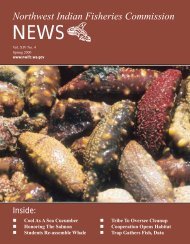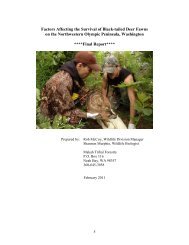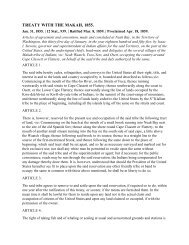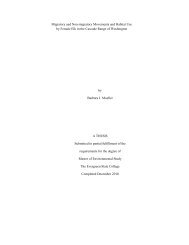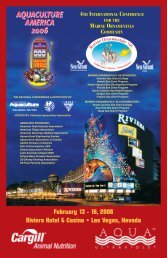Draft TRT Document â for Discussion Purposes ... - NWIFC Access
Draft TRT Document â for Discussion Purposes ... - NWIFC Access
Draft TRT Document â for Discussion Purposes ... - NWIFC Access
You also want an ePaper? Increase the reach of your titles
YUMPU automatically turns print PDFs into web optimized ePapers that Google loves.
<strong>Draft</strong> <strong>TRT</strong> <strong>Document</strong> – <strong>for</strong> <strong>Discussion</strong> <strong>Purposes</strong> – OK to circulaterelatively small stream basins with numerically few natural-origin steelhead.Additionally, hatchery steelhead have been established in some river basins or tributariesfollowing the laddering of, or trapping and hauling operations at, falls or cascades thatwere natural migration barriers (<strong>for</strong> example: Granite Falls on South Fork StillaguamishRiver , Tumwater Falls on the Deschutes River, Sunset Falls on South Fork SkykomishRiver).Furthermore, because of the magnitude of more recent hatchery releases,similarities or differences in abundance trends (especially those based on redd counts) donot necessarily indicate demographic independence or lack thereof. Hatchery fish caninfluence demographic data in three ways.When present on natural spawning grounds, they inflate the abundance ofnaturally spawning fish.Large releases of hatchery fish may reduce the survival of naturally-producedjuveniles.Hatchery releases reduce estimates of natural productivity by adding moreadults to the adult-to-spawner relationship. This is especially true if hatcheryfish produce redds, but subsequent progeny survival is not equivalent to thatof naturally-produced fish.For the purpose of population identification, hatchery influence on populationdemographics may not be as important a factor as it is in the estimation of populationviability. In any event, there are few populations where there is sufficient in<strong>for</strong>mation totest the correlation in abundance trends between populations. Furthermore, a number of<strong>TRT</strong> members identified ocean conditions as having a major influence on populationdemographics, enough so to obscure any freshwater-derived differences.Genetic analysis of spawning aggregations normally provides a quantitativemethod <strong>for</strong> establishing population distinctiveness. However, the influence of hatcheryfish spawning naturally (potential genetic introgression) and the reduced abundance ofnaturally-spawning populations potentially has affected the present day genetic structureof steelhead populations in Puget Sound. In the absence of a historical genetic baseline,it is impossible to estimate the effects of hatcheries or abundance bottlenecks onsteelhead population structure. Despite these caveats, genetic in<strong>for</strong>mation available fromcontemporary samples provided a useful framework <strong>for</strong> population structure in the PugetSound DPS.Population Boundaries <strong>for</strong> Fish and HabitatIn determining population boundaries, two sets of in<strong>for</strong>mation were considered<strong>for</strong> each population. The accessible area of a basin that is used <strong>for</strong> spawning and initialrearing that the fish directly occupy, and the entire basin (based on topography), a portionof which is occupied by the population. By considering the entire basin, oneacknowledges that inaccessible portions of the basin influence stream habitat conditionsin the occupied portion of the basin. It is important to consider historical and24



